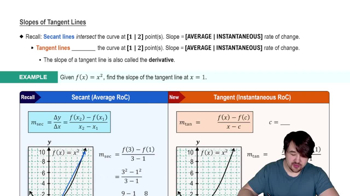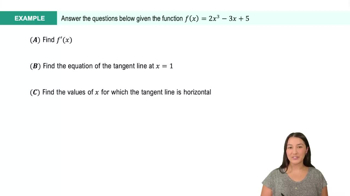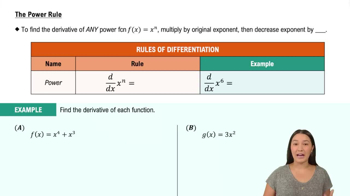Table of contents
- 0. Functions7h 52m
- Introduction to Functions16m
- Piecewise Functions10m
- Properties of Functions9m
- Common Functions1h 8m
- Transformations5m
- Combining Functions27m
- Exponent rules32m
- Exponential Functions28m
- Logarithmic Functions24m
- Properties of Logarithms34m
- Exponential & Logarithmic Equations35m
- Introduction to Trigonometric Functions38m
- Graphs of Trigonometric Functions44m
- Trigonometric Identities47m
- Inverse Trigonometric Functions48m
- 1. Limits and Continuity2h 2m
- 2. Intro to Derivatives1h 33m
- 3. Techniques of Differentiation3h 18m
- 4. Applications of Derivatives2h 38m
- 5. Graphical Applications of Derivatives6h 2m
- 6. Derivatives of Inverse, Exponential, & Logarithmic Functions2h 37m
- 7. Antiderivatives & Indefinite Integrals1h 26m
- 8. Definite Integrals4h 44m
- 9. Graphical Applications of Integrals2h 27m
- 10. Physics Applications of Integrals 2h 22m
3. Techniques of Differentiation
Basic Rules of Differentiation
Problem 67a
Textbook Question
Let f(x) = 4√x - x.
Find all points on the graph of f at which the tangent line is horizontal.
 Verified step by step guidance
Verified step by step guidance1
Step 1: Understand that a horizontal tangent line occurs where the derivative of the function is zero. Therefore, we need to find the derivative of the function f(x) = 4√x - x.
Step 2: Differentiate f(x) with respect to x. The derivative of 4√x is 4 * (1/2)x^(-1/2) = 2x^(-1/2), and the derivative of -x is -1. So, f'(x) = 2x^(-1/2) - 1.
Step 3: Set the derivative equal to zero to find the x-values where the tangent line is horizontal: 2x^(-1/2) - 1 = 0.
Step 4: Solve the equation 2x^(-1/2) - 1 = 0 for x. This involves isolating x by first adding 1 to both sides, then multiplying both sides by x^(1/2), and finally squaring both sides to solve for x.
Step 5: Once you have the x-value(s), substitute back into the original function f(x) to find the corresponding y-value(s). These (x, y) pairs are the points on the graph where the tangent line is horizontal.
 Verified video answer for a similar problem:
Verified video answer for a similar problem:This video solution was recommended by our tutors as helpful for the problem above
Video duration:
4mPlay a video:
Was this helpful?
Key Concepts
Here are the essential concepts you must grasp in order to answer the question correctly.
Derivative
The derivative of a function measures the rate at which the function's value changes as its input changes. It is a fundamental concept in calculus that provides information about the slope of the tangent line to the graph of the function at any given point. To find points where the tangent line is horizontal, we need to set the derivative equal to zero.
Recommended video:

Derivatives
Critical Points
Critical points occur where the derivative of a function is either zero or undefined. These points are significant because they can indicate local maxima, minima, or points of inflection. In the context of finding horizontal tangents, we focus on points where the derivative equals zero, as these correspond to horizontal tangent lines on the graph.
Recommended video:

Critical Points
Tangent Line
A tangent line to a curve at a given point is a straight line that touches the curve at that point without crossing it. The slope of the tangent line is given by the derivative of the function at that point. A horizontal tangent line has a slope of zero, which means we are looking for points where the derivative of the function equals zero.
Recommended video:

Slopes of Tangent Lines

 3:59m
3:59mWatch next
Master Derivatives of Linear Functions with a bite sized video explanation from Callie
Start learningRelated Videos
Related Practice







